What’s that bird of prey?
Identification of raptors can be hard, especially during spring and autumn when all sorts of migrant species are just passing through.
Here, then, are some pointers for our bigger summer residents, to help sort buzzards from the harriers and eagles that breed in the P-O.
Common buzzard
| French : Buse variable | |
| How common | Common |
| When in P-O | All year |
| Where in P-O | Everywhere |
| Wingspan | 1.13-1.28m |
| Underside | Pale & dark variants. Generally: pale underside, with dark chest. Front of wings darker than back, with distinctive dark, “wrist” patch. Some barring |
| Above | Fairly uniform dark brown |
| Key features | Pale U-shaped “necklace” across the middle of chest |
| Flight | They flap more than the other larger raptors: flap-flap-flap-glide |
| Other | The most vocal of larger raptors, usually during flight. Loves to perch on fence-posts |
Booted eagle
| French : Aigle botté | |
| How common | Uncommon |
| When in P-O | April – Sept |
| Where in P-O | Wooded, often more lowland areas. Vallespir, sometimes Albères |
| Wingspan | 1.1-1.35m. (small for an eagle) |
| Underside | Pale and dark forms. Pale form easiest to identify by white body, white leading edge to wing and dark trailing edge and wingtips. |
| Above | Dark brown, with whitish crescent on rump; Diagonal pale bands on wings and white “headlight” spots either side the neck |
| Key features | Impossible to confuse with other species in pale form or seen from above. |
| Flight | Catches prey on the ground, often after a very fast, near-vertical stoop from a great height. |
| Other | Secretive. Never sits about in full view! |
Marsh harrier
| French : Busard des roseaux | |
| How common | Uncommon |
| When in P-O | Some females all year (males & most immatures migrate for the winter) |
| Where in P-O | Marshy areas around reservoirs and wetlands (eg. Canet) |
| Wingspan | 1-1.25m |
| Underside | Male: Dark belly; pale tail & midwings; black wingtips Female: Dark brown with creamy leading edge to midwings |
| Above | Male: Dark back & shoulders; silver-grey midwings & black wingtips Female: Dark brown; creamy head and throat; creamy patch on shoulders |
| Key features | Female’s creamy markings; male’s dark back; both long-tailed & long-winged |
| Flight | Flies low across open ground |
| Other | Similar size to buzzard, but tail longer & more elegant in flight |
Montagu’s harrier
| French : Busard cendré | |
| How common | Uncommon |
| When in P-O | March-June |
| Where in P-O | Arable farmland & garrigue (eg. around Castelnou) |
| Wingspan | 1-1.2m |
| Underside | Male: Red-brown bars on pale underwings; pale, streaked flanks Female: Pale with bold streaks |
| Above | Male: Pale grey with black bar across inner wings; black wingtips Female: brown, with white rump; black bar across inner wings; banded tail |
| Key features | Black bar across inner wings helps differentiate from Hen Harriers |
| Flight | The most elegant of harriers with swept-back, tapered wingtips |
| Other | Easily confused with Hen Harrier (Busard Saint-Martin), which doesn’t breed here but passes through on spring & autumn migration |
Short-toed eagle
| French : Circaète Jean-le-Blanc | |
| How common | Common |
| When in P-O | March-September |
| Where in P-O | Mountains (Albères, Vallespir, Cerdagne) & Roussillon Plain. |
| Wingspan | 1.62-1.78m |
| Underside | Variable dark “hood”. Some darker than others but generally underside appears white at distance. Seen closely: fine barring on wings, body and tail |
| Above | Pale brown |
| Key features | Can appear totally white underneath apart from hood. |
| Flight | Wings appear long relative to body, so less square than buzzard. When hunting, sometimes hovers (legs dangling), before making a fast, long plunge, with wings almost closed. |
| Other | Often mistaken for Bonelli’s Eagle (Aigle de Bonelli), but Bonelli’s are so rare (possibly only 1 bird in the whole of the P-O), you’re most likely watching a Short-toed. Also called Snake Eagle because that’s its favourite prey. |
Golden eagle
| French : Aigle royal | |
| How common | Rare |
| When in P-O | All year |
| Where in P-O | High mountains (mainly Canigou massif. Occasionally in Albères) |
| Wingspan | 1.9-2.2m |
| Underside | Mature adult: uniform dark brown; head golden brown Immature: white patches on wings and tail (which diminish year on year) |
| Above | Uniform dark brown |
| Key features | Very dark & huge! It’s our biggest raptor; anything bigger will be a vulture. |
| Flight | Wide, slow soaring or gliding, with long, splayed “fingertips” |
| Other | Once see, never forgotten |
Below is an immature golden eagle…
In a future edition, we’ll cover the smaller birds of prey : falcons and hawks.

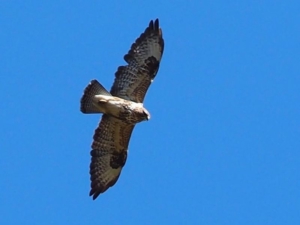

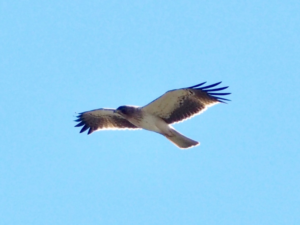
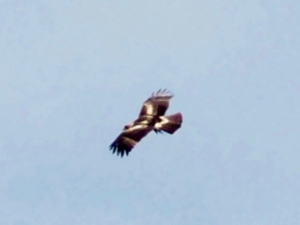

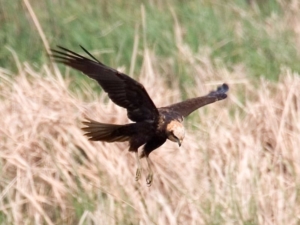
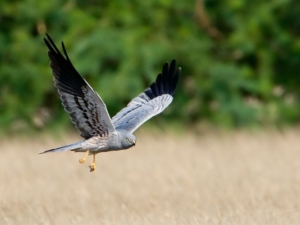
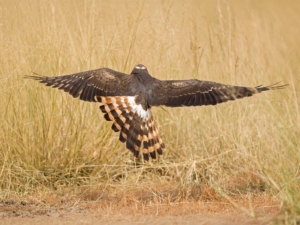

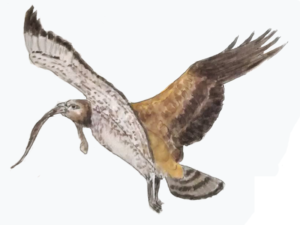
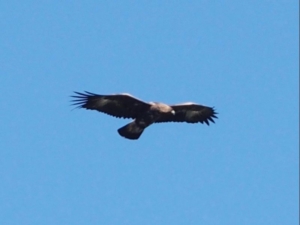
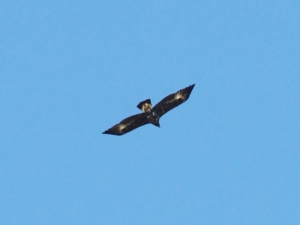
I believe I just spotted a Golden Eagle circling high above my garden. It was exactly the same as your photograph. It was BIG. There were some other large black birds following it, as if keeping it away from their territory/nest. I live in Llanelli, South Wales.
I’ve looked at pictures of the underside of other birds of prey, but the Eagle was the only one identical.
OMG! I think I just saw one exactly how you described above! I’m not a bird watcher but this bird was nothing like I have ever seen before and exactly,ike your photos. The sound it made had my attention immediately and the size… this literally just happened and spotted in carnforth, Lancashire.
Fantastic! Did you get a photo?